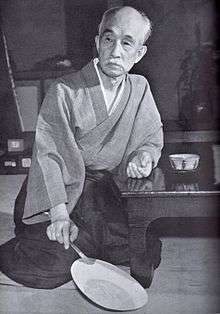Kawai Gyokudō
| Kawai Gyokudō | |
|---|---|
 Kawai Gyokudō | |
| Born |
Kawai Yoshisaburō November 24, 1873 Ichinomiya, Aichi, Japan |
| Died |
June 30, 1957 (aged 83) Tokyo, Japan |
| Nationality | Japanese |
| Known for | Painter |
| Movement | Nihonga |
Kawai Gyokudō (川合 玉堂, November 24, 1873 – June 30, 1957) was the pseudonym of a Japanese painter in the nihonga school, active from Meiji through Shōwa period Japan. His real name was Kawai Yoshisaburō.
Biography
Gyokudō was born in what is now Ichinomiya city, Aichi Prefecture, as the eldest son of a paper, ink and brush merchant. He went to Kyoto in 1887 to study under Kōno Bairei of the Maruyama-Shijo school of painting. In 1896, he moved to Tokyo and he became the student of Hashimoto Gahō, of the Kanō school. He also studied Western-style painting and developed a highly personal style, especially in the field of landscape painting.
Gyokudō is noted for his polychrome and occasionally monochrome works depicting the mountains and rivers of Japan in the four seasons, with humans and animals shown as part of the natural landscape. Among his representative works are Futsuka zuki (“The New Moon”), Yuku haru (“The Departing Spring”), Mine-no-yu (“Evening at the Mountain Top”), and Bosetsu (“Snow in the Evening”).
In 1898, Gyokudō joined with Okakura Tenshin and Yokoyama Taikan to found the Nihon Bijutsuin (Japan Fine Art Academy). In 1907, Gyokudo was selected as a judge for the first annual Bunten Exhibition. He became a teacher at the Tokyo Bijutsu Gakkō (the forerunner of the Tokyo National University of Fine Arts and Music) in 1919.
In 1940, he was awarded the Order of Culture by the Japanese government.
Most of his works are preserved and displayed at the Gyokudo Art Museum, in Ōme, Tokyo.
Major works
Parting spring (1916)
Autumn Rain (1940)
References
- Briessen, Fritz van. The Way of the Brush: Painting Techniques of China and Japan. Tuttle (1999). ISBN 0-8048-3194-7
- Conant, Ellen P., Rimer, J. Thomas, Owyoung, Stephen. Nihonga: Transcending the Past: Japanese-Style Painting, 1868-1968. Weatherhill (1996). ISBN 0-8348-0363-1
- Kimura, Ihee. Four Japanese painters: Taikan Yokoyama, Gyokudo Kawai, Shoen Uemura, Kiyokata Kaburaki (JPS picture books). Japan Photo Service (1939). ASIN: B000888WYA
External links
| Wikimedia Commons has media related to Gyokudō Kawai. |
- brief bio and works
- Spring Rain at Yamagata Art Museum
- Home page to Gyokudo Art Museum (Japanese)
- bio and work at Adachi Museum of Art